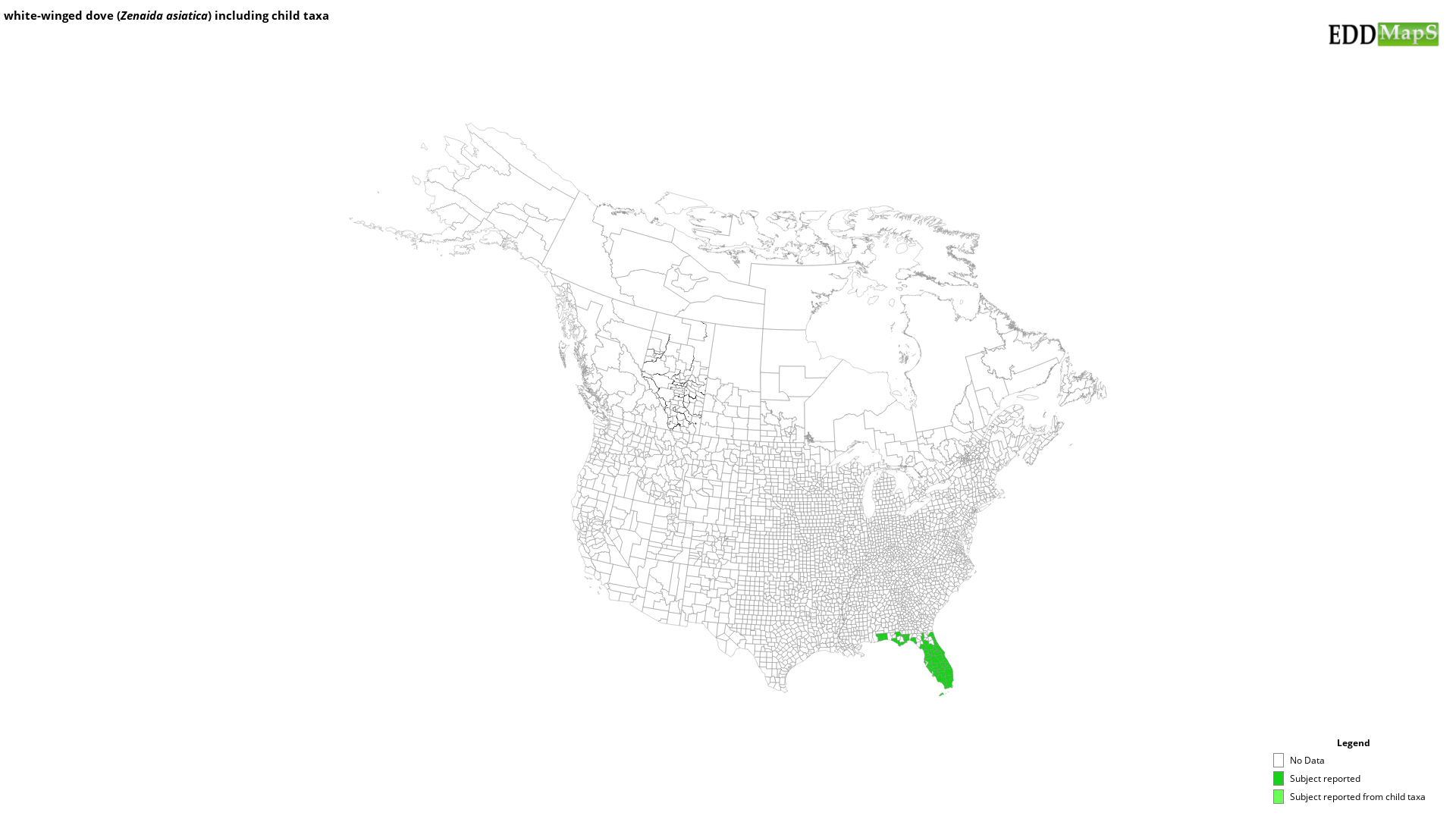white-winged dove
(Zenaida asiatica)
This species is Native to certain parts of the United States but may be invasive to others
Origin
Zenaida asiatica is native to the southwestern United States, Mexico, Central America, and parts of western South America.
Life Cycle
Z. asiatica are plump doves with a small head and square-tipped head. Adult coloration is primarily pale brown with a white stripe along the wing edges and a white-tipped tail. Diet of Z. asiatica consists of seeds. White-winged doves nest on tree branches or a crotch with heavy shade. Males select the territory while females pick the nest site. Females lay 1-2 eggs per clutch with 1-2 broods in a nesting season. The incubation period is 14-20 days with another 13-18 days for the nestling period.
Distribution
Current populations exist across the majority of the United States with high densities in Arizona, Florida, Louisiana, and Texas. Z. asiatica is found in open agricultural lands and suburban areas.
Control Efforts
White-winged doves are not protected species. Management through increased bag limits is recommended to control newly colonized regions.
http://www.columbia.edu/itc/cerc/danoff-burg/invasion_bio/inv_spp_summ/Zenaida_asiatica.html
https://www.allaboutbirds.org/guide/White-winged_Dove/lifehistory#habitat
Zenaida asiatica is native to the southwestern United States, Mexico, Central America, and parts of western South America.
Life Cycle
Z. asiatica are plump doves with a small head and square-tipped head. Adult coloration is primarily pale brown with a white stripe along the wing edges and a white-tipped tail. Diet of Z. asiatica consists of seeds. White-winged doves nest on tree branches or a crotch with heavy shade. Males select the territory while females pick the nest site. Females lay 1-2 eggs per clutch with 1-2 broods in a nesting season. The incubation period is 14-20 days with another 13-18 days for the nestling period.
Distribution
Current populations exist across the majority of the United States with high densities in Arizona, Florida, Louisiana, and Texas. Z. asiatica is found in open agricultural lands and suburban areas.
Control Efforts
White-winged doves are not protected species. Management through increased bag limits is recommended to control newly colonized regions.
http://www.columbia.edu/itc/cerc/danoff-burg/invasion_bio/inv_spp_summ/Zenaida_asiatica.html
https://www.allaboutbirds.org/guide/White-winged_Dove/lifehistory#habitat
Resources
- Animal Diversity Web - University of Michigan Museum of Zoology
- Wikipedia - Wikimedia Foundation, Inc
- The Firefly forest -
Selected Images
Maps
EDDMapS Distribution - This map is incomplete and is based only on current site and county level reports made by experts, herbaria, and literature. For more information, visit www.eddmaps.org
State Lists - This map identifies those states that have this species on their invasive species list or law.
Invasive Listing Sources
Taxonomic Rank
| Domain: Eukarya |
| Kingdom: Animalia |
| Phylum: Chordata |
| Class: Aves |
| Order: Columbiformes |
| Family: Columbidae |
| Subfamily: Columbinae |
| Genus: Zenaida |
| Zenaida asiatica |
References
Common Name Reference: Integrated Taxonomic Information System on-line database.
Scientific Name Reference: Integrated Taxonomic Information System on-line database.


